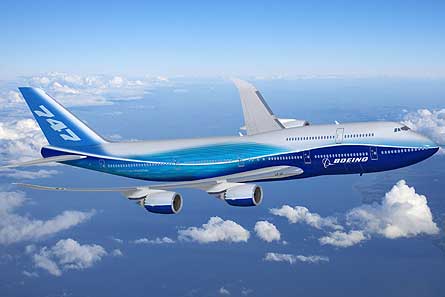By Guy Norris in Los Angeles
Boeing says trade studies for the yet-to-ordered 747-8 Intercontinental include the possible use of electro-chromic window technology now in development for the 787 in place of standard plastic shades.
The company adds the windows will be 16% larger than those of the current -400, thanks to a more efficient structural design derived from the 777.
“We’re able to go to a stringer-less window belt which we’re doing for weight purposes,” says 747 vice president and general manager Jeff Peace. The move to a dimmable window is “a trade study we’re still evaluating,” he adds. The new window shading system is being developed for the 787 by Huntsville, Alabama-based PPG Aerospace in association with Gentex Corporation of Zeeland, Michigan, a maker of automatic-dimming rearview mirrors and commercial fire protection products.
The variably dimmable cabin window which will allow the passenger to select up to five different levels from dark to clear. The windows will also have a manual override for use by the flight crew.
The dimmable electro chromatic window panels will be inserted between the exterior cabin window and an interior plastic dust cover. A low electrical charge will darken a conductive medium between the layers, with transmissibility - or lightness - increasing with reduced voltage.

The trade study comes as design work on the 747-8 (a Boeing artist's impression of which is pictured above)family continues towards firm configuration around September year with major assembly due to begin on the first -8F freighter version in the first quarter of 2008. The 747-8F is due to make its first flight at the end of 2008 and will enter service in the third quarter of 2009 with launch customer Cargolux, while the 747-8 Intercontinental is aimed at service entry in mid-2010.
Providing more details about the latest wing design changes first revealed in Flight International (March 23, 2006), Peace says the greatest increase in wing thickness is “at the side of body and inboard wing. We increased the shape of the aerofoil there to make the inboard wing work harder, and it also gives us the best improvement in bending moment, so from a structural point of view it was efficient.”
The latest wing rendition, which was chosen at the end of April, also increases fuel capacity while maintaining the planned efficiency improvements of the larger design. Fuel consumption is expected to be around 2.6litres per 100 passenger kilometres travelled (PKT) (82 passenger miles/USGal) for the -8 versus 3.06litres/100PTK for the -400 assuming a 100% load factor and a 5,500km (3,000nm) mission range. Fuel capacity for both passenger and freight models has grown by some 14,000litres (3,700USGal) to 241,590litres for the Intercontinental and 229,100litres for the -8F.
Boeing is also embarking on the next round of wind-tunnel testing having just completed work on high- and low-speed lines development and fine-tuning of the noise characteristics on the fully integrated airframe. High-speed testing will continue to be performed at the company’s Transonic Wind Tunnel in Seattle, and further slow speed and noise testing will be completed in the UK at the Qinetiq Low Speed Acoustic Facility (LSAF) at Farnborough. “This will continue through mid-summer,” adds Peace.
“We’re through the initial work and have decided on the firm concept, and now we’re going into the a second period of wind tunnel tests to get pressure measurements for loads to give us a detailed picture of the structure. Once we have that we can move to firm configuration in the third quarter and then release the work statement,” adds Peace.
Source: Flight International



















